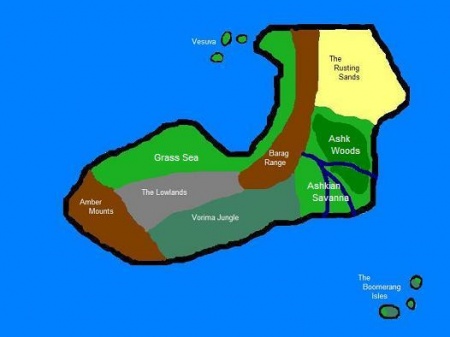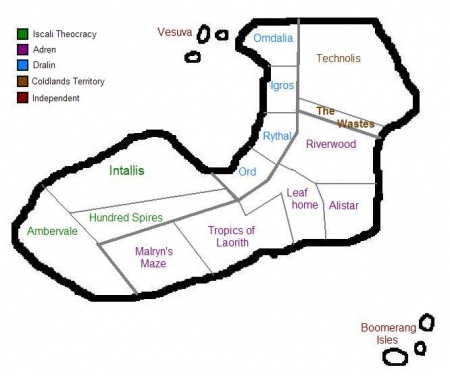Trinity:Ashkar

Located in roughly the center of the world, Ashkar is a highly divided and polarized continent. It has undergone magical transformation at the hands of Kotrit Wayveri, which has caused the northern portion of the continent to undergo serious climate changes over the past few hundred years; it was only in 392 CY, during the Coldlands War, that the region was finally freed of Kotrit's magic.
Since the fall of the Empire of Ashk, the continent's political arena has quieted significantly, as the Empire and the Coldlands Territory did not get along well.
The southern portion of the continent is extremely warm year-round, as it is located on the planet's equator. The region of grassland north of the Lowlands that extends to the northern tip, west of the Barag Range, is a prarie known as as the Grass Sea, while the region south of the Rusting Sands to the Vorima Jungle constitutes a savanna known as the Ashkian Savanna.
Geographical Features[edit]
Rusting Sands[edit]
The Rusting Sands, as they are called, take up almost the entire northern portion of the continent. Prior to Kotrit's meddling, this region was much like the lands west of the mountains, though slightly more arid; it was one of the few places in the world that was farmable. Kotrit knew this, and during the War of the Illusionist, he decimated the area with a vastly-powerful epic spell, putting the region into eternal winter. During this time, it was known as the Coldlands.
After the Coldlands War, the region quickly turned into a windy, incredibly arid desert. The sand was incredibly detrimental to the vast amounts of technology present in the region, causing rail-lines to rust rapidly - hence the desert's name.
Barag Range[edit]
Home to the dwarves of Ashkar, the Barag Range is a relatively calm mountain range, with no exceedingly high peaks and little seismic activity. The mountains are riddled with dwarven and gremlin cities, and are covered in rail-lines.
Ashkian Savanna[edit]
This region consists primarily of grasses and trees unusually resistant to fire; this is probably due to the annual firestorms that rage through the region during the month of Lisyllan. This region gets more rainfall than the desert to the north, but less than the jungle to the south; as one traverses south through the savanna, it gradually becomes less arid. Most of the average annual rainfall of 50 inches or so falls within a three-week period during Alexi.
Ashk Woods[edit]
Some historians hold that this is the ancestral home of the elves; if that is true, that would make these woods the cradle of civilization. This forest is populated by huge, towering trees, the age of which have never been ascertained, as the resident elves refuse to let any cut them down.
The forest is rather rainy, with almost as much annual rainfall as the jungle to the south.
Vorima Jungle[edit]
A thick dense jungle, home to the goblins. Mostly uncivilized and largely unmapped, several attempts have been made to extend civilization further into the jungle reaches - and all have failed. The residents are not entirely unfriendly, though the elves of Adren have found that they are largely territorial.
Home to many strange species of animal that remain largely unidentified, the jungle is a dangerous place.
The Lowlands[edit]
It is thought that, ages ago, there was a vast river that ran between the Barag Range and the Amber Mounts, which carved its way through the rock. What remains is a rocky wasteland that is several dozen feet below sea-level, filled with hundreds of towering rock spires. Rain from the jungle runs down into the crevasses of this place, giving its few inhabitants a rapid means of transport. As hot as the jungle to the south and much less comforting, the Lowlands are a dangerous place.
Grass Sea[edit]
This is an extensive prarie, reaching from the Lowlands and the Amber Mounts to the northwestern tip of the continent - though it greatly resembles the Ashkian Savanna when it reaches the southwest. Much of the grasses that grow here are extremely tall, almost reaching the average height of a human. The soil in this region is unusually rich, and the climate lacking in extremes, such that this region is one of the very few that benefit from agriculture.
Wild horses are also common to the area, some of which are domesticated and used as mounts by the nations of the continent.
Amber Mounts[edit]
Nations[edit]
